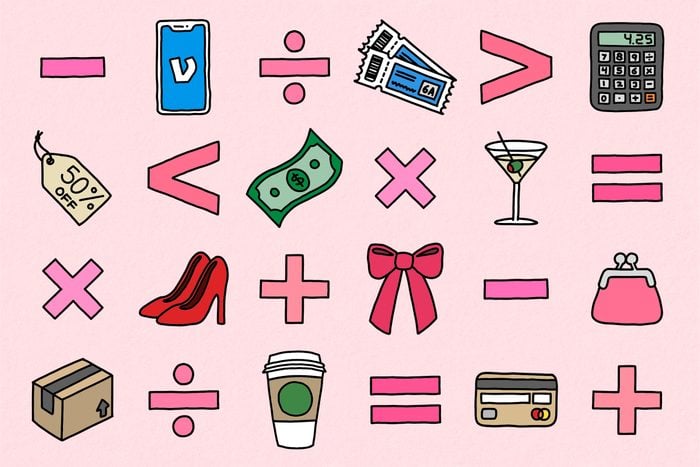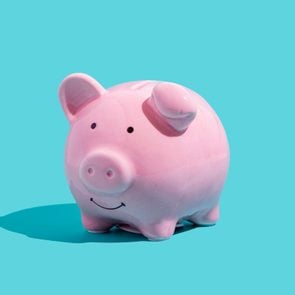How I Use “Girl Math” to Fuel My Everyday Splurges
Updated: Nov. 23, 2023

Is this viral TikTok trend lightheartedly silly, or is girl math furthering stereotypes?
While I am financially savvy, I’m also into some lighthearted spending logic. And if your math brain works anything like mine, we might agree on some things: anything less than $5 is free; it’s smart to buy an extra item for free shipping; and returning a $50 item at Target before spending $100 is like getting 50% off.
This kind of mental accounting is known as “girl math,” and I’m one of its biggest proponents. I’m not alone: What started as a TikTok trend has become an all-out sensation. People debate whether it is “fun or foolish,” according to the Washington Post, as well as whether gendering such a term reinforces a problematic stereotype that women generally are bad at math or don’t know how to save money. But at the end of the day, it’s not about budgeting or shopping smarter or making good or bad financial decisions; it’s about having some responsible fun with money. Here’s what you need to know.
Get Reader’s Digest’s Read Up newsletter for money, humor, cleaning, travel, tech and fun facts all week long.
@samjamessssss just girl things #girldinner #girlmath ♬ original sound – samjamess
What is girl math?
It’s described as the economic gymnastics that people go through to justify a purchase. If you find $20 in your pocket, it’s a windfall you must spend on something fun. Cancel your dinner plans with friends? You just made money. Any funds sent to you as reimbursement on payment apps (such as Venmo) is free cash. Spend $200 on shoes and wear them all fall and winter? That’s just about $1 a day.
The term got its start on TikTok with real estate developer and content creator Samantha James, whose TikTok video in August defining this pop-cultural sensation has more than 3.6 million views. (For what it’s worth, she said the term has been in Urban Dictionary since 2010, so the idea has been around for a while.) Her rules were simple: Girl math is about justifying purchases that bring you joy, even if the numbers don’t technically add up.
Using girl math as a conversation starter
I first heard of girl math while driving to pick up a pair of designer jeans for $5 on what I lovingly call the “mom swap,” or Facebook Marketplace. I was queuing up a podcast, and I noticed one of my favorite financial planners had used the term “girl math” in her title. I pressed play.
Melissa Fradenburg is the host of the Women’s Money Wisdom podcast and a certified divorce financial analyst and accredited investment fiduciary with Pearl Planning in Michigan. When I called her about the girl math phenomenon she spoke about on her podcast, she told me she understands when people react strongly to girl math as illogical or nonsensical. But she looks at the term as a conversation starter.
“More women should be talking about personal finance and about how they make financial decisions,” Fradenburg says. “Women in many families make most of the financial decisions, like budgeting or buying groceries and clothing. So if we buy two items when it’s ‘buy one, get one 50% off’ and feel like we got a deal, that can be OK, as long as you are managing your money overall.”
Fradenburg says social media trends like girl math sparked additional terms, such as “boy math,” where men were taken to task for their justification of golf club purchases or Elon Musk’s purchase of Twitter. Debating stereotypes is worthwhile, she says, and anyone talking about how they spend, savor or invest money makes her happy.
Girl math “rules”
Girl math operates on its own set of rules, some of which make sense on the surface—and some that might have you scratching your head. Many are based on sound financial principles, such as the sunk-cost fallacy. Here are some of my favorite girl math “rules.”
- Anything under $5 is free.
- Dresses cost you half because they take the place of a shirt and pants.
- If you pay in cash, the item is free.
- If you don’t buy an item on sale, you lose money.
- If you pay with your credit card and people give you cash (or Venmo you cash), you’ve made money.
- If you get refunded for something after the fact, that item is free.
- Spending more to get free shipping saves you money.
- Skipping Starbucks means you’ve made money that day.
- Canceled plans? You can spend more the next time you go out.
- Any money spent at [your favorite retailer] doesn’t count.
When to be cautious with girl math
The backlash against girl math came swiftly. When I posted about the viral term on Facebook, more than half the comments were outraged—these were women I admired saying they “hated it,” found the phrase “absurd” or “offensive” and that it could be justifying overspending.
Gaurav Saran, founder and CEO of ReverseLogix, understands how the trend took off but says he believes girl math can lead to financial regret for those who practice it. “There’s a high chance it will become a pop-culture term that we’ll always use because there’s enough of a catchiness to it,” Saran says. “And that’s because it partly makes sense. If you buy a pair of $100 jeans, you can tell yourself it really only costs you $5 per wear if you end up wearing them 20 times. But you only have so much money in the bank, no matter what you tell yourself. And $5 is not free. It will catch up with you.”
Tips to use girl math responsibly
For decades, personal-finance experts have offered suggestions on how to handle your money like an adult. So, there is plenty of good advice out there that helps people determine the best way to save, spend, invest—and justify purchases. Here are some ways that I’ve personally adjusted girl math to work in my everyday life.
- Set a budget for your monthly splurges and carry that amount of money in cash.
- Create a clothing allowance and follow a capsule wardrobe, so what you buy works with items you already own in your closet.
- Pay your important bills first, like your rent, car payment and food, so the rest is discretionary. (You can also learn how to lower your bills.)
- Set up auto payments so you know what you can spend in your bank account at all times.
- Avoid putting things you cannot afford on credit cards, and pay your bill in full each month.
Girl math is full of contradictions, and that’s OK
Granted, I’m no “girl” anymore. I’m debt-free with a stable income. I’m married, and we both agree on saving for our goals, including retirement. I listen to financial podcasts weekly, whether it’s Dave Ramsey, Ramit Sethi’s I Will Teach You to Be Rich, Paula Pant on Afford Anything or So Money with Farnoosh Torabi. And while I was decent at math, I studied English in college and became a writer, so people sometimes assume I’m bad with numbers.
So I understand why people have such visceral reactions to the girl math concept. Math is challenging for some people, and those women who work as mathematicians, CEOs and CFOs, as well as financial experts, likely have faced scrutiny that their experience and education doesn’t hold merit.
Still, I feel girl math is a “universal experience,” as one TikTok creator said, not a moral panic. The term helped me understand how I approached purchases that I wanted to make but found hard to do if I wanted to save money. I know nothing is free and that I should live within my means. But, for the record, those $5 mom-swap jeans fit like a dream, and I strutted around in them.
Is girl math the starting point to financial wellness?
According to the Guardian, TikToks with the hashtag #GirlMath have been viewed more than 488 million times. To say this term hit a nerve is an understatement. I’m with Fradenburg—let’s open up a conversation around financial wellness using girl math as our starting point.
What I appreciate about girl math is that it caused me to review my spending with a new lens. If I wanted to buy something to treat myself, I could. Based on Fradenburg’s experience, women are great long-term savers and investors, and I fit that bill. As long as I’m thoughtful about the big purchases or my overall savings, I can enjoy money and buy clothing I love or notebooks I eventually will fill (I promise).
Is it all a bit silly? Sure. But overall, having money to “live our rich life,” as Ramit Sethi says, is a good thing. “It’s not about good versus bad financial decisions. If buying that smoothie after your workout makes you happy, then you should do it, and you can justify it any way you want to,” said James on TikTok. “It’s money well spent. Girl Math for all.”
About the experts
- Melissa Fradenburg is a certified divorce financial analyst and accredited investment fiduciary with Pearl Planning in Michigan and co-host of the “Women’s Money Wisdom” podcast.
- Gaurav Saran is the founder and CEO of ReverseLogix, which helps brands with product returns and reverse logistics. Previously, Gaurav was with Microsoft, where he led enterprise sales and drove strategic executive relationships.
Sources:
- Buzzfeed: “This TikToker Just Brought Up ‘Girl Math, and It’s Probably the Most Accurate Thing I’ve Ever Heard”
- Washington Post: “‘Girl math’ is fun, but don’t let it fool you”
- Women’s Money Wisdom: “The Role of ‘Girl Money’ in Financial Literacy for Women”
- The Guardian: “‘Can’t we have a funny joke?’ Why #girlmath is dividing TikTok”
- Ramit Sethi: “I will teach you to be rich”
- TikTok: Samantha James



